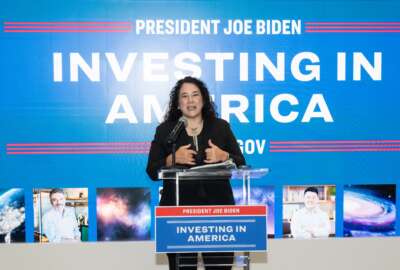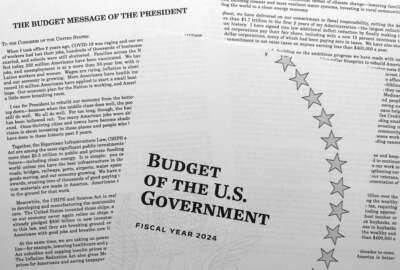How regulations not meant for contractors, sometimes end up complicating their business
When agencies enact new rules aimed at curtailing some aspects of the larger national economy they can sometimes lead to conflicting impacts on federal contracting,...
When agencies enact new rules aimed at curtailing some aspects of the larger national economy they can sometimes lead to conflicting impacts on federal contracting, both for the companies and the federal agencies. There are a couple of recent examples that the Federal Drive Host Tom Temin discussed with David Berteau, president and CEO of the Professional Services Council. We also got into what the fourth quarter could look like for contractors after the last one didn’t perform as well as though.
Interview Transcript:
David Berteau Every year, of course, in July we’re beginning to think, Ok, what does August and September look like? Agencies historically, and you can look at the data, it shows is every fourth quarter is usually the biggest quarter for contract obligations in the federal government in almost every agency, in almost every year. The things that set you up for this, though, is what’s happened before you get to the fourth quarter, how much money is left? One of the things that we saw this year, FY 23, was because of appropriations occurred in December instead of March. [Office of Management and Budget (OMB)] was able to issue money to the agencies in January, or in some cases early February. So they were not as far into fiscal year 23 before they began having full access to their funding. So we saw a boom second quarter. In fact, in many agencies it was the largest second quarter on record and even the ones where it wasn’t. There’s usually a reason for it, like a giant F-35, in the first quarter instead of a second quarter for the Defense Department. So that led us to wonder, Ok, will the third quarter also be a boom? Because if got a big second quarter or a big third quarter, there’s just not as much left over for the fourth quarter. Well, we finally got good data for the third quarter for civilian agencies. We put it together last week at PSC. And then what we saw was third quarter was down a good bit, not even as big as last year. Well, last year, of course, they didn’t get their money until the third quarter, in FY 22. So it’s not surprising that third quarter would be bigger than the second quarter. This year they got their money in the second quarter. So the second quarter was bigger. What that tells us, though, is there is substantial funding remaining in most agencies to obligate funds in the fourth quarter. So we’ll probably see a big fourth quarter. But there’s a couple other factors I’ll bring up if you’d like.
Eric White Oh, yes, please do.
David Berteau So one is the uncertainty about, not only whether we’re going to start the fiscal year under a continuing resolution, but even what the level of that CR would be. Eric, in the last 20 or 25 years, every CR has pretty much been at the level of the previous year’s spending. So you could plan on having FY 23 level funding come October 1st under a CR. The appropriators say they’re going to get their bills done by Sept.30., then we’ll start the year on time. But 18 out of the last 20, or 19 out of 20 for some agencies, it has started under the CR. We can sort of plan on it, we’ll do it again this year. But now there’s more uncertainty as to the level. With House Republicans having already cut back on the debt limit deal, The Fiscal Responsibility Act, which originally set spending to be roughly equal to 23 level for civilian agencies. Now they’re saying, no let’s go back to the FY 22 level. And even that’s not distributed in a peanut butter slice pattern across the agency. Some agency is getting much bigger cuts than others. So a CR at an FY 23 level is not a guarantee. You could start a CR at a lower level. So that puts a premium on two things. Number one is, obligating the money you have now in the fourth quarter, and plus starting new programs so that they will be new starts under the CR. But the second is, if the money’s not expiring, do you want to obligate it all now? Do you want to save some of it in case if CR funding is even lower than the FY 23 level? Those are competing dynamics we have no visibility into what the agencies are thinking or what their guidance is in the aggregate way. But those could have both a stimulating and a constraining effect on Q4 spending. So we’ll be watching that very closely.
Eric White And plus, it can vary from agency to agency, I imagine.
David Berteau Tremendously, and what the needs are, what’s ready to go. You’ve seen a lot of hiccups in some of the government wide acquisition contracts that agencies planned on having ready to go here, Polaris, CIO-SP4, these things are now being reworked and redone. So the vehicles that agencies thought might be available by September or August are not necessarily available. So they’ve got to find other vehicles in place. Programs are not as ready to go as they might have been otherwise. A lot of constraining factors here. Nonetheless, we can’t expect it’s going to be a very robust fourth quarter. We just can’t tell exactly where and when.
Eric White Speaking with David Berteau from the Professional Services Council. Another thing I wanted to ask you about is, there are a lot of rules that come from the [Federal Trade Commission (FTC)] and [Securities and Exchange Commission (SEC)], and even sometimes [Consumer Financial Protection Bureau CFPB)] that many don’t think would pertain to federal contractors. There mostly trying to take aim at other industries where they’re seeing some shenanigans and stuff, but then end up having an effect on federal contracting. And we may have seen a couple come to light recently. And I was curious on if you could tell me a little bit more about the PSC stance on the merger guidelines that recently came from FTC, and as well as the proposed cyber and climate disclosures from the SEC.
David Berteau It’s really been a very interesting and expanded dynamic for us, the Professional Services Council, Eric. We’re very accustomed to providing comments on proposed changes to the Federal Acquisition Regulation or the Defense supplement, the DFARS, or other agencies, so each of whom have their own acquisition regulations as well. That’s something the PSC has been doing for decades. But in the last few years we’ve seen a lot more agencies that are not aiming necessarily at federal contracting or solely at federal contracting, but they do have a big impact, and they go through different procedures. You mentioned the FTC’s new merger guidelines. Last week, the White House had a big event on competition and they issued these guidelines and asked for public comment on them, 50 something pages long. The guidelines really are how does the FTC look at whether a merger is something they’re going to challenge and ask the Justice Department to file a lawsuit to prevent the merger from happening or to adjust or mitigate aspects of it. And that’s mostly aimed at a broader American commercial market or even the global marketplace. But it has a big impact potentially on a lot of government contractors.
David Berteau If you look at the basic dynamic of government contracting, if you start as a small business and then you grow out of satisfied world, you’ve got to compete. But you’re pretty small, so you’re competing with a bunch of big guys. So you have to grow, and you can grow organically, but that’s slow, or you can grow by mergers and acquisitions, either buying or being bought. So that dynamic is built into the ecosystem of government contracting, unless you want to stay small forever. And most companies do not. They would like to grow, they like to expand their business, they’re in it for good reasons to support the missions and they want to keep going. So all of that says that the FTC may have rules that are for the broader marketplace, but they’ll have special impact on government contractors who are already subject to a lot of additional rules, as you well know, that commercial companies are not subject to. We don’t find that those agencies like the FTC or the Securities and Exchange Commission often think about this from the perspective of the government contractors. And we’ll be filing comments and getting input from our members on the FTC merger guidelines, but we’ll also be looking and already have looked at some of the previous ones that you mentioned, the SEC, and there’s also the SEC climate rules, the SEC disclosures on cybersecurity, as well as the Federal Trade Commission’s proposed rule earlier this year to ban non-compete clauses, which has some unique dynamics in government contracting business because you have to bid key personnel. And oftentimes those bids have to last for months and months and months beyond when you thought you were going to get an award. So how do you keep those key personnel tied to your bid? If they’re not there, you won’t win. And if they can leave and go to another company, boy, you’re really in trouble with your bid at that point.
Eric White And in those agencies defense, as somebody who covers this industry, even sometimes I look at a role and go, Oh that’s not our story, that doesn’t pertain to us. And don’t even think like, Oh yeah, wait, there are a lot of mergers that happen in the contracting world. Aren’t there?
David Berteau There are, and sometimes the FTC and the Justice Department weigh in on them. We had one last year that was thrown out by the courts, and others that ecently been thrown out by the courts, we tracked them. Mostly at PSC we track the ones that affect government contracting, but we like to look at the broader dynamic as well, because that can set the stage for other cases that will have an impact on us.
Copyright © 2024 Federal News Network. All rights reserved. This website is not intended for users located within the European Economic Area.
Tom Temin is host of the Federal Drive and has been providing insight on federal technology and management issues for more than 30 years.
Follow @tteminWFED






